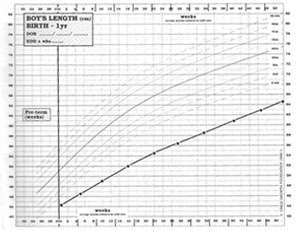CARTILAGE AND BONE DISORDERS
Diagnosis : Majority at birth by radiological examination
Treatment : Usually surgical limb lengthening, GH in trials
There are a large number of bone disorders that affect growth; they are mostly rare and many are inhertited. They are known as skeletal dysplasias and the best known is achondroplasia.
 Children and adults with achondroplasia have short upper arms and thighs, a normal length back, a large head, and a characteristic face with depressed nasal bridge, small nose and large forehead. They appear to have large muscles for their leg length. They are of normal intelligence and health. Achondroplasia is caused by a mutation of a single gene and has a dominant pattern of inheritance. This means that, on average, half the children of a parent with achondroplasia will be affected. In most cases, however, there is a new mutation, without any family history and it seems that this particular gene is one of the most unstable in the human complex.
Children and adults with achondroplasia have short upper arms and thighs, a normal length back, a large head, and a characteristic face with depressed nasal bridge, small nose and large forehead. They appear to have large muscles for their leg length. They are of normal intelligence and health. Achondroplasia is caused by a mutation of a single gene and has a dominant pattern of inheritance. This means that, on average, half the children of a parent with achondroplasia will be affected. In most cases, however, there is a new mutation, without any family history and it seems that this particular gene is one of the most unstable in the human complex.
At present, treatment depends primarily on new surgical techniques of limb lengthening. Growth hormone treatment may improve short-term growth rate, especially if started at an early age. However, it is not yet known whether this improves final height and growth hormone use in this condition is therefore still being evaluated through clinical trials.
This is a similar syndrome to achondroplasia but the physical characteristics and short stature are less marked. Like achondroplasia, the short legs are responsible for the short stature. The face is normal (though it has some tell tale features to the experienced eye) and children with hypochondroplasia often may be diagnosed as being very short normal’s. Hypochondroplasia is also inherited as a dominant gene, but seems to be separate from the achondroplasia gene; the two condition very seldom appear in the same family. In hypochondroplasia, one of the parents frequently has the disorder.
There is no certain way of confirming what is sometimes a difficult diagnosis. The most helpful feature is comparison of sitting-height and leg-length centiles. While in achondroplasia the X-ray signs are marked and characteristic, in hypochondroplasia they are minimal. The effect growth hormone treatment is being evaluated through clinical trials.
There are over one hundred such conditions of which achondroplasia and hypochondroplasia are two of the most common. Other bone disorders are more rare; some affect limbs only, some the trunk and some both. To date, none have any specific treatment although surgical limb lengthening is potentially the most promising, while the use of growth hormone is being evaluated through clinical trials.
Further contact : Dr. (Prof.) I.P.S. Kochar
For Appointment :